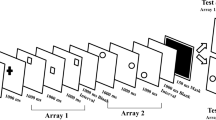Abstract
A modulation of Fitts’s Law occurs when rapid pointing movements are made to targets within a placeholder array. Although Fitts’s Law predicts increasing movement times with larger movement amplitudes, with the placeholder array the furthest target is reached faster than the second furthest. This study analyzed the timing of this effect by removing placeholders at either target onset or movement onset. Placeholders shown during movement planning were sufficient to cause the violation of Fitts’s Law. Placeholders removed at the target onset did not produce the last position advantage, a result which was confirmed in an independent data set. Together, these results converge with recent proposals that pinpoint the contribution of allocentric information to visuo-motor control largely to the movement planning stage.


Similar content being viewed by others
References
Adam JJ, Pratt J, Fischer MH (2006) Moving further but faster—an exception to Fitts’s Law. Psychol Sci 17(9):794–798
Al-Aidroos N, Fischer MH, Adam JJ, Pratt J (2008) Structured perceptual arrays and the modulation of Fitts’s Law: examining saccadic eye movements. J Motor Behav 40(2):155–164
Augustyn JS, Rosenbaum DA (2005) Metacognitive control of action: perception for aiming reflects knowledge of Fitts’s Law. Psychon Bull Rev 12(5):911–916
Decety J, Jeannerod M (1996) Mentally simulated movements in virtual reality: does Fitts law hold in motor imagery? Behav Brain Res 72:127–134
Fischer MH, Pratt J, Adam JJ (2007) On the timing of reference frames for action control. Exp Brain Res 183:127–132
Fitts PM (1954) The information capacity of the human motor system in controlling the amplitude of movement. J Exp Psychol 47(6):381–391
Glover S (2002) Visual illusions affect planning but not control. Trends Cogn Sci 6:288–292
Glover S (2004) Separate visual representations in the planning and control of action. Behav Brain Sci 27:3–78
Goodale MA, Milner AD (1992) Separate visual pathways for perception and action. Trends Neurosci 15:20–25
Grosjean M, Shiffrar M, Knoblich G (2007) Fitts’s Law holds for action perception. Psychol Sci 18(2):95–99
Milner AD, Goodale MA (2008) Two visual systems re-viewed. Neuropsychologia 46:774–785
Neely KA, Tessmer A, Binstead G, Heath M (2008) Goal-directed reaching: movement strategies influence the weighing of allocentric and egocentric visual cues. Exp Brain Res 186:375–384
Pratt J, Adam JJ, Fischer MH (2007) Visual layout modulates Fitts’s Law: the importance of first and last positions. Psychon Bull Rev 14(2):350–355
Schenk T (2006) An allocentric rather than perceptual deficit in patient D.F. Nat Neurosci 9(11):1369–1370
Woodworth RS (1899) The accuracy of voluntary movement. Psychol Rev 3(3 suppl 13):1–119
Author information
Authors and Affiliations
Corresponding author
Rights and permissions
About this article
Cite this article
Bradi, A.C., Adam, J.J., Fischer, M.H. et al. Modulating Fitts’s Law: the effect of disappearing allocentric information. Exp Brain Res 194, 571–576 (2009). https://doi.org/10.1007/s00221-009-1733-5
Received:
Accepted:
Published:
Issue Date:
DOI: https://doi.org/10.1007/s00221-009-1733-5




